SATCAT no. 25605 Launch date 3 January 1999 Last contact 3 December 1999 | Mission type Lander COSPAR ID 1999-001A Max speed 24,780 km/h Cost 110 million USD Manufacturer Lockheed Martin | |
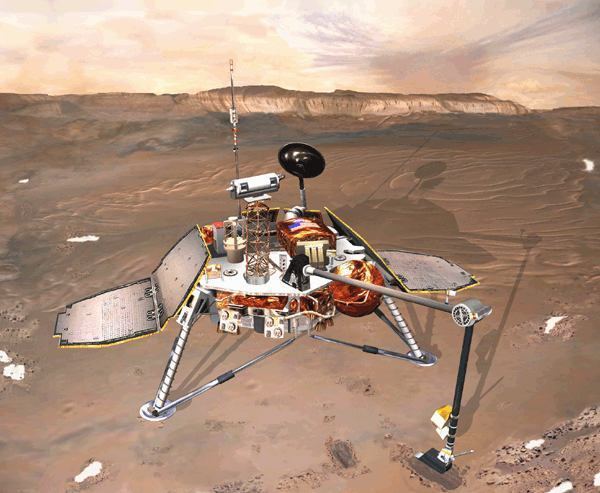 | ||
Website Mars Polar Lander website Similar | ||
Usa nasa unable to detect mars polar lander signal
The Mars Polar Lander, also known as the Mars Surveyor '98 Lander, was a 290-kilogram robotic spacecraft lander launched by NASA on January 3, 1999 to study the soil and climate of Planum Australe, a region near the south pole on Mars. It formed part of the Mars Surveyor '98 mission. On December 3, 1999, however, after the descent phase was expected to be complete, the lander failed to reestablish communication with Earth. A post-mortem analysis determined the most likely cause of the mishap was premature termination of the engine firing prior to the lander touching the surface, causing it to strike the planet at a high velocity.
Contents
- Usa nasa unable to detect mars polar lander signal
- Usa nasa s mars polar lander blasts off from cape canaveral
- History
- Deep Space 2 Probes
- Spacecraft design
- Attitude control and propulsion
- Communications
- Power
- Scientific instruments
- Launch and trajectory
- Landing attempt
- Intended operations
- Loss of communications
- References
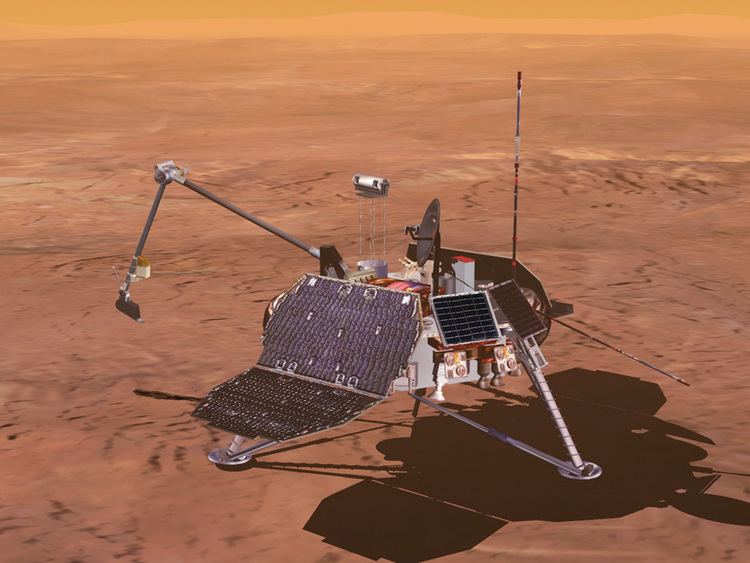
Usa nasa s mars polar lander blasts off from cape canaveral
History
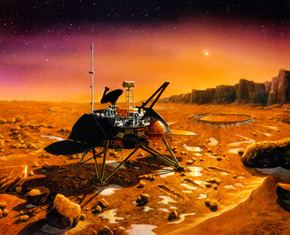
As part of the Mars Surveyor '98 mission, a lander was sought as a way to gather climate data from the ground in conjunction with an orbiter. NASA suspected that a large quantity of frozen water may exist under a thin layer of dust at the south pole. In planning the Mars Polar Lander, the potential water content in the Martian south pole was the strongest determining factor for choosing a landing location. A CD-ROM containing the names of one million children from around the world was placed on board the spacecraft as part of the "Send Your Name to Mars" program designed to encourage interest in the space program among children.
The primary objectives of the mission were to:
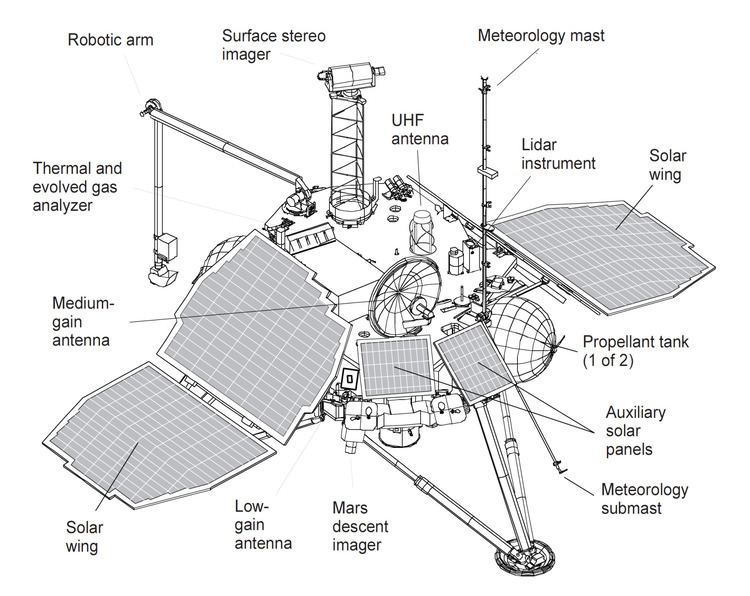
Deep Space 2 Probes
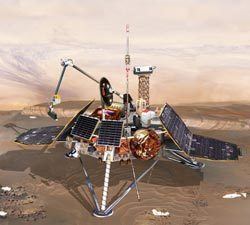
The Mars Polar Lander carried two small, identical impactor probes known as "Deep Space 2 A and B". The probes were intended to strike the surface with a high velocity at approximately 73°S 210°W, to penetrate the Martian soil, and study the subsurface composition up to a meter in depth. However, after entering the Martian atmosphere, attempts to contact the probes failed.
Spacecraft design
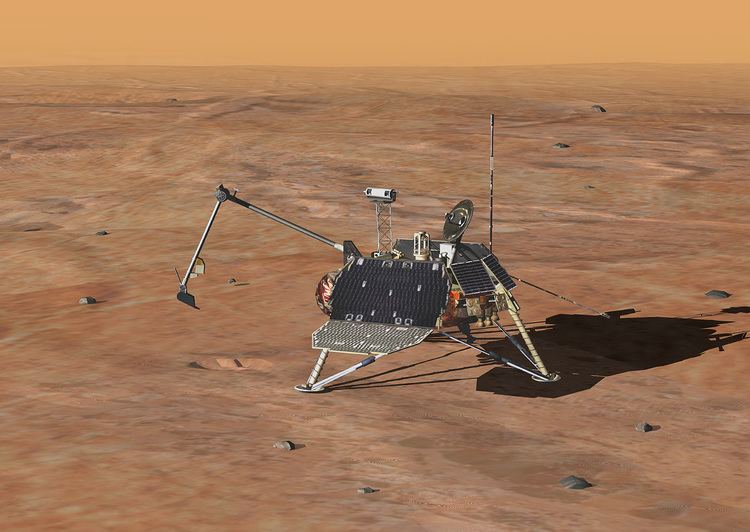
The spacecraft measured 3.6 meters wide and 1.06 meters tall with the legs and solar arrays fully deployed. The base was primarily constructed with an aluminum honeycomb deck, composite graphite epoxy sheets forming the edge, and three aluminum legs. During landing, the legs were to deploy from stowed position with compression springs and absorb the force of the landing with crushable, aluminum honeycomb inserts in each leg. On the deck of the lander, a small thermal Faraday cage enclosure housed the computer, power distribution electronics and batteries, telecommunication electronics, and the capillary pump loop heat pipe (LHP) components, which maintained operable temperature. Each of these components included redundant units in the event that one may fail.
Attitude control and propulsion
While traveling to Mars, the cruise stage was three-axis stabilized with four hydrazine monopropellant reaction engine modules, each including a 22-newton trajectory correction maneuver thruster for propulsion and a 4-newton reaction control system thruster for attitude control. Orientation of the spacecraft was performed using redundant Sun sensors, star trackers, and inertial measurement units.
During descent, the lander used three clusters of pulse modulated engines, each containing four 266-newton hydrazine monopropellant thrusters. Altitude during landing was measured by a doppler radar system, and an attitude and articulation control subsystem (AACS) controlled the attitude to ensure the spacecraft landed at the optimal azimuth to maximize solar collection and telecommunication with the lander.
The lander was launched with two hydrazine tanks containing 64 kilograms of propellant and pressurized using helium. Each spherical tank was located at the underside of the lander and provided propellant during the cruise and descent stages.
Communications
During the cruise stage, communications with the spacecraft were conducted over the X band using a medium-gain, horn-shaped antenna and redundant solid state power amplifiers. For contingency measures, a low-gain omni-directional antenna was also included.
The lander was originally intended to communicate data through the failed Mars Climate Orbiter via the UHF antenna. With the orbiter lost on September 23, 1999, the lander would still be able to communicate directly to the Deep Space Network through the Direct-To-Earth (DTE) link, an X band, steerable, medium-gain, parabolic antenna located on the deck. Alternatively, Mars Global Surveyor could be used as a relay using the UHF antenna at multiple times each Martian day. However the Deep Space Network could only receive data from, and not send commands to, the lander using this method. The direct-to-Earth medium-gain antenna provided a 12.6-kbit/s return channel, and the UHF relay path provided a 128-kbit/s return channel. Communications with the spacecraft would be limited to one-hour events, constrained by heat-buildup that would occur in the amplifiers. The number of communication events would also be constrained by power limitations.
Power
The cruise stage included two gallium arsenide solar arrays to power the radio system and maintain power to the batteries in the lander, which kept certain electronics warm.
After descending to the surface, the lander was to deploy two 3.6-meter-wide gallium arsenide solar arrays, located on either side of the spacecraft. Another two auxiliary solar arrays were located on the side to provide additional power for a total of an expected 200 watts and approximately eight to nine hours of operating time per day.
While the Sun would not have set below the horizon during the primary mission, too little light would have reached the solar arrays to remain warm enough for certain electronics to continue functioning. To avoid this problem, a 16-amp-hour nickel hydrogen battery was included to be recharged during the day and to power the heater for the thermal enclosure at night. This solution also was expected to limit the life of the lander. As the Martian days would grow colder in late summer, too little power would be supplied to the heater to avoid freezing, resulting in the battery also freezing and signaling the end of the operating life for the lander.
Scientific instruments
Launch and trajectory
Mars Polar Lander was launched on January 3, 1999, at 20:21:10 UTC by the National Aeronautics and Space Administration from Space Launch Complex 17B at the Cape Canaveral Air Force Station in Florida, aboard a Delta II 7425 launch vehicle. The complete burn sequence lasted for 47.7 minutes after a Thiokol Star 48B solid-fuel third stage booster placed the spacecraft into an 11-month, Mars transfer trajectory at a final velocity of 6.884 kilometers per second with respect to Mars. During cruise, the spacecraft was stowed inside an aeroshell capsule and was powered and communicated with Earth with the a segment known as the cruise stage.
Landing attempt
On December 3, 1999, Mars Polar Lander encountered Mars while mission operators began preparing for landing operations. At 14:39:00 UTC, the cruise stage was jettisoned, beginning a planned communication dropout until the spacecraft had touched down on the surface. Six minutes prior to atmospheric entry, a programmed 80-second thruster firing turned the spacecraft to the proper entry orientation, with the heat shield oriented to absorb the 1,650 °C heat that would be generated as the descent capsule passed through the atmosphere.
Traveling at 6.9 kilometers per second, the entry capsule entered the Martian atmosphere at 20:10:00 UTC and was expected to land in the vicinity of 76°S 195°W in a region known as Planum Australe. Communication was expected to be reestablished with the spacecraft at 20:39:00 UTC after having landed. However, no communication was possible with the spacecraft and the lander was declared lost.
On May 25, 2008 the Phoenix lander arrived at Mars, and has subsequently completed most of the objectives of the Mars Polar Lander, carrying several of the same or derivative instruments.
Intended operations
Traveling at approximately 6.9 kilometers/second and 125 kilometers above the surface, the spacecraft entered the atmosphere and was initially decelerated by using a 2.4 meter ablation heat shield, located on the bottom of the entry body, to aerobrake through 116 kilometers of the atmosphere. Three minutes after entry, the spacecraft had slowed to 496 meters per second signaling an 8.4-meter, polyester parachute to deploy from a mortar followed immediately by heat shield separation and MARDI powering on, while 8.8 kilometers above the surface. The parachute further slowed the speed of the spacecraft to 85 meters per second when the ground radar began tracking surface features to detect the best possible landing location.
When the spacecraft had slowed to 80 meters per second, one minute after parachute deployment, the lander separated from the backshell and began a powered descent while 1.3 kilometers aloft. The powered descent was expected to have lasted approximately one minute, bringing the spacecraft 12 meters above the surface. The engines were then shut off and the spacecraft would expectedly fall to the surface and land at 20:15:00 UTC near 76°S 195°W in Planum Australe.
Lander operations were to begin five minutes after touchdown, first unfolding the stowed solar arrays, followed by orienting the medium-gain, direct-to-Earth antenna to allow for the first communication with the Deep Space Network. At 20:39 UTC, a 45-minute transmission was to be broadcast to Earth, transmitting the expected 30 landing images acquired by MARDI and signaling a successful landing. The lander would then power down for six hours to allow the batteries to charge. On the following days, the spacecraft instruments would be checked by operators and science experiments were to begin on December 7 and last for at least the following 90 Martian Sols, with the possibility of an extended mission.
Loss of communications
On 3 December 1999, at 14:39:00 UTC, the last telemetry from Mars Polar Lander was sent, just prior to cruise stage separation and the subsequent atmospheric entry. No further signals were received from the spacecraft. Attempts were made by Mars Global Surveyor to photograph the area in which the lander was believed to be. An object was visible and believed to be the lander. However, subsequent imaging performed by Mars Reconnaissance Orbiter resulted in the identified object being ruled out. Mars Polar Lander remains lost.
The cause of the communication loss is not known. However, the Failure Review Board concluded that the most likely cause of the mishap was a software error that incorrectly identified vibrations, caused by the deployment of the stowed legs, as surface touchdown. The resulting action by the spacecraft was the shutdown of the descent engines, while still likely 40 meters above the surface. Although it was known that leg deployment could create the false indication, the software's design instructions did not account for that eventuality.
In addition to the premature shutdown of the descent engines, the Failure Review Board also assessed other potential modes of failure. Lacking substantial evidence for the mode of failure, the following possibilities could not be excluded:
The failure of the Mars Polar Lander took place two-and-a-half months after the loss of the Mars Climate Orbiter. Inadequate funding and poor management have been cited as underlying causes of the failures. According to Thomas Young, chairman of the Mars Program Independent Assessment Team, the program "was under funded by at least 30%."
